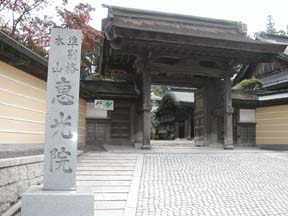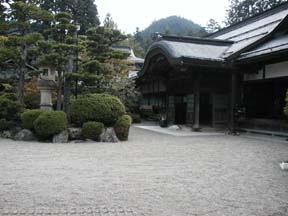|
Eko-in |
| TEL |
0736-56-2514 |
including 2 meals 10,500 ~ 12,600 yen
Okomori plan 5,000 yen  Jalan net (Japanese version only) Jalan net (Japanese version only)
|
| Access |
|
| Parking |
There is a parking lot |
| Time |
Check-in 15:00 Check-out 10:00 |
| Room |
37 guest room , max 150 people |

 
I left my luggage at Eko-in in the morning. (I stayed at a different shukubo on the previous day.) Then I rented a bicycle at the tourist information desk (guarantee: 1,000 yen and pay at an hourly rate, Fee for one day: 1,200 yen) Although I expected a tough ride because Mount Koya is a mountain, but the tough locations were limited to the steep slope from the center to the right in front of Daimon and in front of Nyonin-do. The rest was easy. Although the area is not vast in distance, a bicycle can take you many places. In Kondo, which I visited right after renting the bicycle, they were conducting Syomyo of Fudangyo because it was Bon season in August. I was enchanted by the solo of a good looking young priest.
On August 13, they hold the Candle Festival from 17:30. Therefore, we ate dinner from 16:30 on that day. The Shojin cuisine served in the room was really delicious. Compared with the shukubo that I stayed at on the previous day, this place was larger in scale. In terms of accommodation facilities, it was more sophisticated. I ordered sake. Although the room cannot be locked, a safe is provided in the room.
The Large Torch passes in front of the lodging around 18:30 and the Candle Festival starts from 19:00. The shukubo is only several hundred meters from Oku-no-in. In this festival, worshippers light up complimentary candles along both sides of the 1.9 kilometer approach. The candles dimly light up the tomb stones in the dark. It was consoling to the spirits of the dead and was fantastic to me. I was enchanted by the Syomyo in Oku-no-In.
We returned to the lodging at around 21:30. The bath is open until 23:00. The bath has six washing spaces and is quite clean. I got together with people from abroad, one from San Francisco and the other from Canada. They said that they enjoyed the Candle Festival and it was quiet and nice there.
On the 14th, only people who wished to participated in the morning service at the main hall from 6:30. I sat crossing my legs in front of me from the beginning as my knees ached. It ended in half an hour. After that, the people who wanted to moved on to the Goma hall and participated in the Goma burning. It was the first time for me to see it closely. I was impressed by the flame and the various behaviors of the priests.
Breakfast was served from a little past seven-thirty in the hall. Naturally, it was shojin cuisine. I was enchanted by the Syomyo for two days and had a pleasant time.
Also, at Eko-in, an Okomori plan is conducted on the 20th every month. (The accommodation plan for Okomori can be reserved from  Jalan net (Japanese version only).) Jalan net (Japanese version only).)
Although many of the shukubo lodgings on Mount Koya charge 10,000 yen or more, with an Okomori plan, the accommodation fee is only 5,000 yen. I stayed in an eight-tatami mat room called Jin, which I had to share with another person. But the space was large enough.
I practiced shakyo (copying sutra by hand) with the person who shared the room with me from 15:30. Then, from 17:30, we had dinner. For the accommodation fee of 5,000 yen, they served a tasty and neat meal including vegetable tempura, buckwheat noodles with mountain plants, pickles and cooked rice. The person who shared the room with me was staying from the previous day. According to the fellow lodger, the dinner on the previous evening was not very different. The same shojin foods as just mentioned above added with cooked vegetables, sesame tofu and a persimmon. So, the Okomori Plan is absolutely beneficial.
We worshipped at Oku-no-in from 19:00. Oku-no-in at night was really scary without the temple staff. I hear that originally the worship is supposed to be made at two o'clock. How scary that would be! We were able to listen to explanations from the temple staff, which were more detailed than those given by general guides. At the side of the statue of Kobo-Daishi, the priest chanted the sutra. There were people who were doing Ohyakudo-mairi (100 time worshiping). The space was filled with a sacred and mysterious atmosphere. I myself was filled with gratitude. At 21:20, we went back to Eko-in and found our futon mattress spread out in the room. The restroom located next to our room was very new and was completely clean. Warm water came out automatically when I reached under the faucet to wash my hands.
On the next day, we got up at 6:00 and joined the morning service from 6:30. Although they keep the heaters on, it was quite cold (in November). At around 7:00, we went out from the gate and went to the hall of Goma right next to the hall. It was good that I had a coat. The piece of wood used for Goma was also cheap (300 yen) and I had my rosary prayed over. I was very grateful.
When I returned home from the hall of the Goma prayer, the high school priests were cleaning the temple. I was impressed to know it was the efforts of these young priests that made the Eko-in completely clean. It was really refreshing. Going back to my room, I found that breakfast was ready: miso soup, cooked vegetables, pickles and cooked rice. After the meal, I participated in Ajikan meditation. It was a little regrettable that I could not concentrate on the image of the full moon due to the cold.
The Okomori Plan of Eko-in was very satisfying. I can recommend it with confidence.
|
Please confirm the latest information at the time of lodging.
|
|

